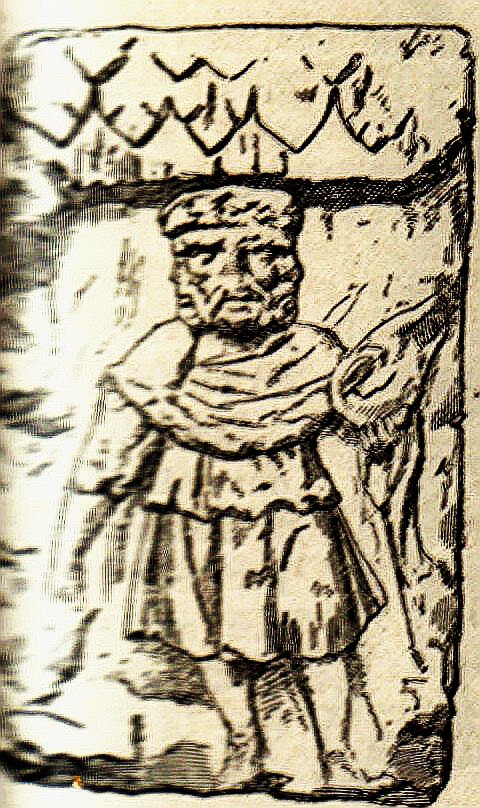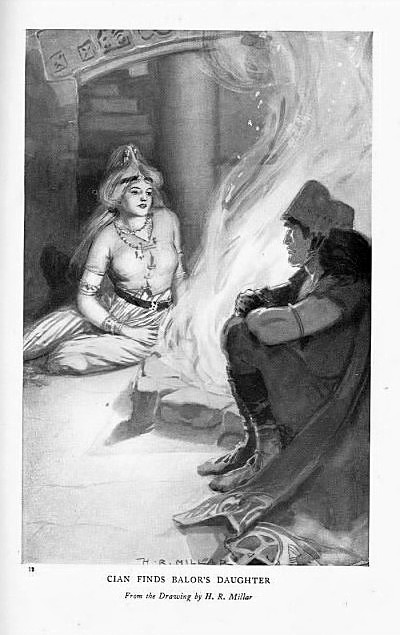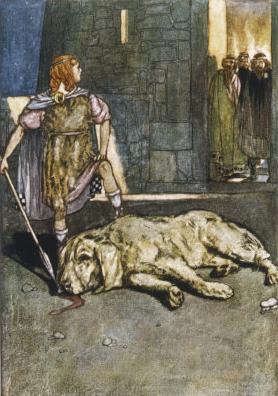|
Lugh
Lugh or Lug (; ga, label= Modern Irish, Lú ) is a figure in Irish mythology. A member of the Tuatha Dé Danann, a group of supernatural beings, Lugh is portrayed as a warrior, a king, a master craftsman and a savior.Olmsted, Garrett. ''The Gods of the Celts and the Indo-Europeans''. University of Innsbruck, 1994. p.117 He is associated with skill and mastery in multiple disciplines, including the arts.Monaghan, Patricia. ''The Encyclopedia of Celtic Mythology and Folklore''. Infobase Publishing, 2004. pp.296-297 Lugh also has associations with oaths, truth and the law, and therefore with rightful kingship.Koch, John T. ''Celtic Culture: A Historical Encyclopedia''. ABC-CLIO, 2006. p.1200 Lugh is linked with the harvest festival of Lughnasadh, which bears his name. His most common epithets are ''Lámfada'' ("long hand" or "long arm", possibly for his skill with a spear or his ability as a ruler) and ''Samildánach'' ("equally skilled in many arts"). In mythology, Lugh is ... [...More Info...] [...Related Items...] OR: [Wikipedia] [Google] [Baidu] |
Lughnasadh
Lughnasadh or Lughnasa ( , ) is a Gaelic festival marking the beginning of the harvest season. Historically, it was widely observed throughout Ireland, Scotland and the Isle of Man. In Modern Irish it is called , in gd, Lùnastal, and in gv, Luanistyn. Traditionally it is held on 1 August, or about halfway between the summer solstice and autumn equinox. In recent centuries some of the celebrations have been shifted to the Sunday nearest this date. Lughnasadh is one of the four Gaelic seasonal festivals, along with Samhain, Imbolc and Beltane. It corresponds to other European harvest festivals such as the Welsh and the English Lammas. Lughnasadh is mentioned in some of the earliest Irish literature and has pagan origins. The festival itself is named after the god Lugh. It inspired great gatherings that included religious ceremonies, ritual athletic contests (most notably the Tailteann Games), feasting, matchmaking, and trading. Lughnasadh occurred during a very poor ... [...More Info...] [...Related Items...] OR: [Wikipedia] [Google] [Baidu] |
Balor
In Irish mythology, Balor or Balar was a leader of the Fomorians, a group of malevolent supernatural beings. He is often described as a giant with a large eye that wreaks destruction when opened. Balor takes part in the Battle of Mag Tuired, and is primarily known from the tale in which he is killed by his grandson Lugh of the Tuatha Dé Danann. He has been interpreted as a personification of the scorching sun, and has also been likened to figures from other mythologies, such as the Welsh Ysbaddaden and the Greek Cyclops. Name The name ''Balor'' or The Lonni may come from Common Celtic ''*Boleros'', meaning "the flashing one". In the early literature he is also referred to as ''Balor Béimnech'' (Balor the smiter), ''Balor Balcbéimnech'' (Balor the strong smiter), ''Balor Birugderc'' (Balor of the piercing-eye), ''Balor mac Doit meic Néid'' (Balor, son of Dot son of Nét) or ''Balor ua Néit'' (Balor, grandson of Nét). Later forms are ''Balor Béimeann'' or ''Balar Be ... [...More Info...] [...Related Items...] OR: [Wikipedia] [Google] [Baidu] |
Failinis
AW IHN-ishor is a dog in the Mythological Cycle of Irish literature, belonging to Lugh Lámhfhada of the Tuatha Dé Danann; it was one of the eric (reparation) items exacted from the sons of Tuireann. It was originally the a hound-whelp of the smith or the king of Iruaith (Ioruath, Hiruaidhe, etc.). Later on, Lugh's Failinis (var. Fer Mac) belonged to a foreign threesome from Iruaith that came to Ireland, and encountered by the Fíanna led by Fionn mac Cumhaill in the Fenian cycle. Name variants The puppy is referred to as the "whelp of the royal smith of Ioruath" but otherwise unnamed in the 12th century ''Lebor Gabála Érenn'' ("Book of Invasions") version of the story of the sorrows of the sons of Tuireann. It is named in the lengthier, romance version of this story, ''Fate of the Children of Tuireann'' or '' Oidheadh Chloinne Tuireann'', abbreviated OCT of much later date, with the earliest manuscript dating to the 17th century. Eugene O'Curry hypothesized the na ... [...More Info...] [...Related Items...] OR: [Wikipedia] [Google] [Baidu] |
Irish Mythology
Irish mythology is the body of myths native to the island of Ireland. It was originally passed down orally in the prehistoric era, being part of ancient Celtic religion. Many myths were later written down in the early medieval era by Christian scribes, who modified and Christianized them to some extent. This body of myths is the largest and best preserved of all the branches of Celtic mythology. The tales and themes continued to be developed over time, and the oral tradition continued in Irish folklore alongside the written tradition, but the main themes and characters remained largely consistent. The myths are conventionally grouped into ' cycles'. The Mythological Cycle consists of tales and poems about the god-like Túatha Dé Danann, who are based on Ireland's pagan deities, and other mythical races like the Fomorians. Important works in the cycle are the '' Lebor Gabála Érenn'' ("Book of Invasions"), a legendary history of Ireland, the '' Cath Maige Tuired' ... [...More Info...] [...Related Items...] OR: [Wikipedia] [Google] [Baidu] |
Cian
In Irish mythology, Cian or Cían (), nicknamed Scal Balb, was the son of Dian Cecht, the physician of the Tuatha Dé Danann, and best known as the father of Lugh Lamhfada. Cían's brothers were Cu, Cethen, and Miach. Cían was slain by the Sons of Tuireann, for which Lugh demanded various treasures around the world as éraic (compensation), according to the account in the "Book of Invasions" ('' Lebor Gabála Érenn'', LGE) as well as the late romance version "The Fate of the Children of Tuireann". Name Cían means "enduring one"; ''cían'' signifying "long, enduring, far, distant". Scal Balb Lebor Gabála Érenn, , p. 101 (Introduction); ¶311 p. 116 ¶330 p. 148–, ¶368 p. 186– is a nickname borne by other personages and means "dumb champion", with "dumb" in the sense of unable to make speech. By most accounts, Lug's mother is the Fomorian princess Ethniu, Lebor Gabála Érenn, ed. tr. ¶311 p. 117 but according to an interpolated text the LGE, Cían is also ... [...More Info...] [...Related Items...] OR: [Wikipedia] [Google] [Baidu] |
Tuatha Dé Danann
The Tuath(a) Dé Danann (, meaning "the folk of the goddess Danu (Irish goddess), Danu"), also known by the earlier name Tuath Dé ("tribe of the gods"), are a supernatural race in Irish mythology. Many of them are thought to represent deity, deities of pre-Christian Gaelic Ireland. The Tuath Dé are often depicted as kings, queens, druids, bards, warriors, heroes, healers and craftsmen who have supernatural powers. They dwell in the Celtic Otherworld, Otherworld but interact with humans and the human world. They are associated with the ''sídhe'': prominent ancient burial mounds such as Brú na Bóinne, which are entrances to Otherworld realms. Their traditional rivals are the Fomorians (Fomoire), who might represent the destructive powers of nature, and whom the Tuath Dé defeat in the Cath Maige Tuired, Battle of Mag Tuired. Prominent members of the Tuath Dé include The Dagda ("the great god"); The Morrígan ("the great queen" or "phantom queen"); Lugh; Nuada Airgetlám, N ... [...More Info...] [...Related Items...] OR: [Wikipedia] [Google] [Baidu] |
Enbarr
The Enbarr (Énbarr) or Aonbharr of Manannán ( ga, Aonbharr Mhanannáin) is a horse in the Irish Mythological Cycle which could traverse both land and sea, and was swifter than wind-speed. The horse was the property of the sea-god Manannan mac Lir, but provided to Lugh Lamh-fada ( ga, Luġ Lámhfhada) to use at his disposal. In the story '' Oidheadh Chloinne Tuireann'' ("The Fate of the Children of Tuireann"), Lugh refused to lend it to the sons of Tuireann, but was then forced to lend the self-navigating boat ''Sguaba Tuinne'' (Wave-sweeper) instead. Forms Aenbharr or Aonbharr ( ga, Aonbarr) occur in '' Oidheadh Chloinne Tuireann''. In P.W. Joyce's retelling the horse is also called Enbarr of the Flowing Mane. The forms Énbarr, Enbhárr are given by James Mackillop's dictionary. Etymology The meaning of this name has variously defined. As a common noun ''enbarr'' is glossed as "froth" in the medieval Cormac's glossary. O'Donovan, John tr. (1868),Enbarr, ''Sanas Chormaic'' ... [...More Info...] [...Related Items...] OR: [Wikipedia] [Google] [Baidu] |
Lugus
Lugus was a deity of the Celtic pantheon. His name is rarely directly attested in inscriptions, but his importance can be inferred from place names and ethnonyms, and his nature and attributes are deduced from the distinctive iconography of Gallo-Roman inscriptions to Mercury, who is widely believed to have been identified with Lugus, and from the quasi-mythological narratives involving his later cognates, Welsh Lleu Llaw Gyffes (Lleu of the Skillful Hand) and Irish Lugh Lámhfhada (Lugh of the Long Arm). Etymology The etymology of the name is debated. Besides the Gaulish ''Lugos'' (plural ''Lugoues'', ''Lugouibus''), the deity is attested in Old Irish ''Lug'' (Ogham: ''Lugu''-), Middle Welsh ''Llew'', and Celtiberian ''Luguei'', which may point to a Common Celtic origin of the cult.' The Proto-Celtic compound ''*Lugu-deks'' ('serving the god Lug') can also be reconstructed from Gaulish ''Lugudeca'' and Old Irish ''Lugaid''.' The theonym can also be found in the place names ... [...More Info...] [...Related Items...] OR: [Wikipedia] [Google] [Baidu] |
Fragarach
In Irish mythology, Fragarach (or ''Freagarthach''), known as "The Whisperer", "The Answerer", or "The Retaliator", was the sword of Nuada, the first high king. The sword was forged by the gods and was meant to be wielded only by those who posed above the stone of destiny (the Lia Fail) which roared and the sword whispered in response. Nuada lost his arm in the first battle of Mag Tuired and, being mutilated, was no longer suitable to be high king. So, for the second battle of Mag Tuired, Nuada choose Lugh as provisional king. Using his spear and a sling given to him by Mannanan Mac Lyr, Lugh defeated the Formorians and their king Balor. During the battle, Nuada gave Lugh his sword, as a symbol of the king. Neither the poems nor the Lebor Gabála Érenn say whether Lugh wielded the sword in the battle. It was said that, with Fragarach at their throat, no one could move or tell a lie, thus the name "Answerer". The sword was also said to place the wind at the user's command ... [...More Info...] [...Related Items...] OR: [Wikipedia] [Google] [Baidu] |
Ethniu
In Irish mythology, Ethniu (), or Eithne ( Modern Irish pronunciation: ) in modern spelling, is the daughter of the Fomorian leader Balor, and the mother of Lugh. She is also referred to as Ethliu (modern Eithle), Eithlionn (genitive; modern Eithleann), and Ethlinn (dative; modern Eithlinn). Name Ethniu is a fine example of the difficulty of conducting research into Irish mythology. Her oldest version of her name is probably Ethliu or Ethniu, giving rise to the modern Irish name Eithne. However thanks to changes in the Irish language, the lack of standardised spelling for many centuries, and attempts to anglicise the name, variations have arisen. Linguistic ignorance has further confused the issue: the genitive form of ''Ethniu'' is ''Ethnenn'' (modern ''Eithneann'') and the genitive of ''Ethliu'' is ''Ethlenn/Ethlinn'' (modern ''Eithleann/Eithlinn''), as in ''mac Ethlenn'' ("Ethliu's son"). This genitive has often been taken for a nominative, or a mistaken nominative has be ... [...More Info...] [...Related Items...] OR: [Wikipedia] [Google] [Baidu] |
Assembly Of Talti
The Tailteann Games, Tailtin Fair, Áenach Tailteann, Aonach Tailteann, Assembly of Talti, Fair of Taltiu or Festival of Taltii were funeral games associated with the semi-legendary history of Pre-Christian Ireland. There is a complex of ancient earthworks dating to the Iron Age in the area of Teltown where the festival was historically known to be celebrated off and on from medieval times into the modern era. History and archaeology The games were founded, according to the ''Book of Invasions'', by Lugh Lámhfhada, the Ollamh Érenn (master craftsman or doctor of the sciences), as a mourning ceremony for the death of his foster-mother Tailtiu. Lugh buried Tailtiu underneath a mound in an area that took her name and was later called Tailteann in County Meath. The event was held during the last fortnight of July and culminated with the celebration of Lughnasadh, or Lammas Eve (1 August). Modern folklore claims that the Tailteann Games started around 1600 BC, with some sources cl ... [...More Info...] [...Related Items...] OR: [Wikipedia] [Google] [Baidu] |
Cú Chulainn
Cú Chulainn ( ), called the Hound of Ulster ( Irish: ''Cú Uladh''), is a warrior hero and demigod in the Ulster Cycle of Irish mythology, as well as in Scottish and Manx folklore. He is believed to be an incarnation of the Irish god Lugh, who is also his father. His mother is the mortal Deichtine, sister of king Conchobar mac Nessa. Born Sétanta, he gained his better-known name as a child, after killing Culann's fierce guard dog in self defence and offering to take its place until a replacement could be reared, hence he became the "Hound (''cú'') of Culann". He was trained in martial arts by Scáthach, who gave him the spear Gáe Bulg. It was prophesied that his great deeds would give him everlasting fame, but that his life would be short. At the age of seventeen he defends Ulster single-handedly against the armies of queen Medb of Connacht in the famous '' Táin Bó Cúailnge'' ("Cattle Raid of Cooley"). He is known for his terrifying battle frenzy (''ríastra ... [...More Info...] [...Related Items...] OR: [Wikipedia] [Google] [Baidu] |
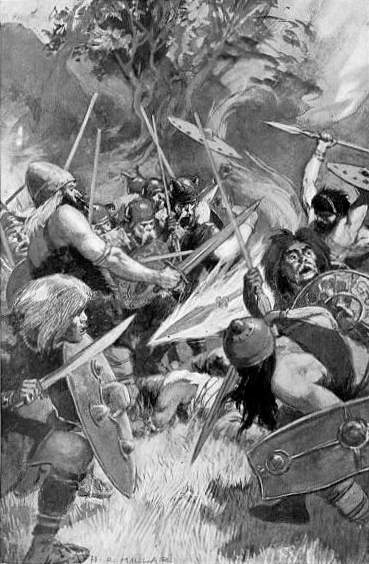
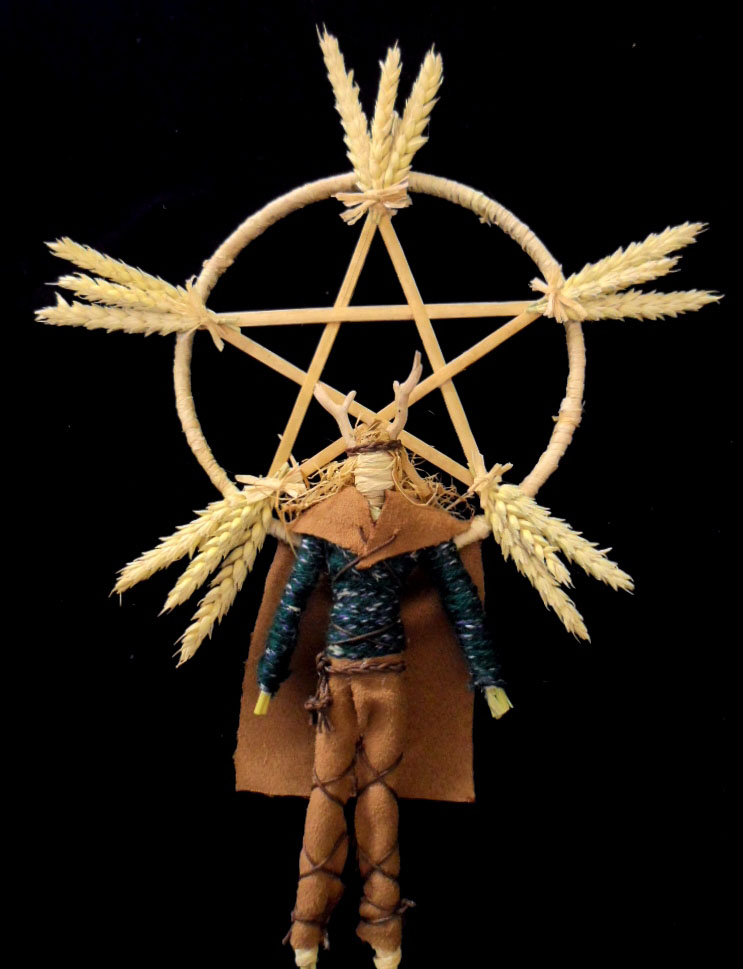
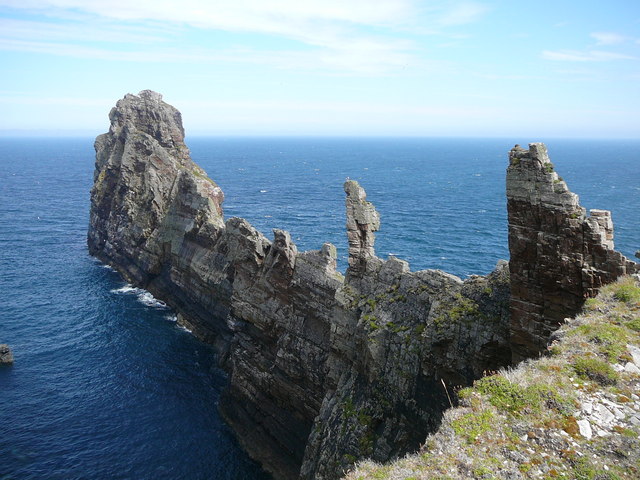
.jpg)
